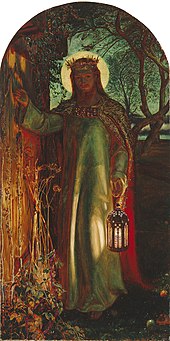The Light of the World (painting)

The Light of the World (1851–1854) is an

Composition
Many speculated about the identity of the model. In January 1898, Edward Clodd sent Hunt a copy of a newspaper article on the subject, asking for Hunt's verification. Hunt had earlier told Clodd
… of my having used a cast from a clay model made by me, with a variety of male sitters, my father, Millais, John Capper and, in person, furtively from Carlyle, also from many departed heroes in effigy – the best I could get serving as my model for different parts of the head …
Hunt replied that "What [the author of the article] says about Miss Christina Rossetti sitting for the head . . . is true," which Rossetti did after Hunt felt he had "secured the male character in the head."[4]

Versions
The original is variously said to have been painted at night in a makeshift hut at
A second, smaller version of the work, painted by Hunt between 1851 and 1856, is on display at
The fact that, at the time, Keble College charged a fee to view the picture,[5] persuaded Hunt to paint a larger, life-sized, version toward the end of his life. He began it in about 1900 and finished in 1904. Shipowner and social reformer, Charles Booth, purchased the work and it was hung in St Paul's Cathedral, London. It was dedicated there in 1908, following a 1905–1907 world tour, during which the picture drew large crowds.[11] It was claimed that four-fifths of Australia's population viewed it.[12] Due to Hunt's increasing infirmity and glaucoma, he was assisted in the completion of this version by English painter Edward Robert Hughes (who also assisted with Hunt's version of The Lady of Shalott). The third version diverges more from the original than the second one.
Reception
The painting gave rise to much popular devotion in the late Victorian period and inspired several musical works, including Arthur Sullivan's 1873 oratorio The Light of the World.[3] Engraved reproductions were widely hung in nurseries, schools and church buildings.[12]
References
- ^ "William Holman Hunt Artworks". The Art Story. Archived from the original on 27 October 2020. Retrieved 8 January 2021.
- ^ Hunt, W. H. (1905). Pre-Raphaelitism and the Pre-Raphaelite Brotherhood. Vol. I. London: Macmillan. p. 350.
- ^ a b Landow, George P. (December 2001). "The Light of the World". Victorian Web. Archived from the original on 14 September 2020. Retrieved 3 September 2016.
- ^ Amor, Anne Clark (1989). William Holman Hunt: The True Pre-Raphaelite. London: Constable. pp. 255–256.
- ^ ISBN 0-333-39917-X.
- ^ a b "Chapel History and Treasures". Keble College. Retrieved 3 September 2016.
- ^ Hunt 1905, pp. 299–300.
- ISBN 978-1-118-33137-8. Retrieved 19 January 2013.
- ^ "Inside the Chapel". Keble College. Retrieved 2 September 2016.
- ^ "The Light of the World". Art UK. Retrieved 24 March 2019.
- ^ "The Light of the World". St Paul's Cathedral. Retrieved 3 September 2016.
- ^ a b Fulford, Robert (24 December 2007). "The Light fantastic: Loved but neglected painting of Jesus became a touchstone of mass culture". National Post. Retrieved 3 September 2016.
Further reading
- Maas, Jeremy (1984). Holman Hunt and the Light of the World. Ashgate. ISBN 978-0-85967-683-0.
